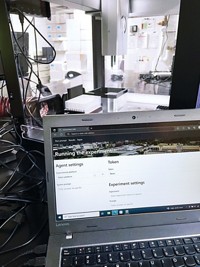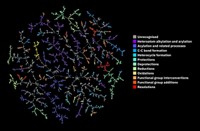Advertisement
Grab your lab coat. Let's get started
Welcome!
Welcome!
Create an account below to get 6 C&EN articles per month, receive newsletters and more - all free.
It seems this is your first time logging in online. Please enter the following information to continue.
As an ACS member you automatically get access to this site. All we need is few more details to create your reading experience.
Not you? Sign in with a different account.
Not you? Sign in with a different account.
ERROR 1
ERROR 1
ERROR 2
ERROR 2
ERROR 2
ERROR 2
ERROR 2
Password and Confirm password must match.
If you have an ACS member number, please enter it here so we can link this account to your membership. (optional)
ERROR 2
ACS values your privacy. By submitting your information, you are gaining access to C&EN and subscribing to our weekly newsletter. We use the information you provide to make your reading experience better, and we will never sell your data to third party members.
Computational Chemistry
Chematica could help chemists avoid patented synthetic routes
Algorithm identifies patented parts of syntheses, but lawyers point out it may miss the subtleties of the intellectual property
by Sam Lemonick
January 17, 2019
| A version of this story appeared in
Volume 97, Issue 3

Pharmaceutical companies employ teams of lawyers and intellectual property experts to make sure synthetic routes to new molecules can be protected and don’t infringe on existing patents. Now the creators of Chematica, an artificial intelligence–driven retrosynthesis planner, have demonstrated an algorithm they say can help chemists find routes to molecules that avoid what others have already patented (Chem 2019, DOI: 10.1016/j.chempr.2018.12.004). But lawyers aren’t sure a computer can handle the subtleties of intellectual property law.
Bartosz A. Grzybowski of the Polish Academy of Sciences and Ulsan National Institute of Science and Technology and colleagues developed the Chematica software, which uses machine learning to plot synthetic routes to target molecules using some 50,000 rules of chemical reactions the team taught it. Grzybowski sold Chematica to MilliporeSigma in 2017. Last year, the researchers demonstrated that the program could chart routes to target molecules that chemists could then follow successfully in the lab.
In the new work, the team pairs this synthesis planning with an algorithm that searches patent literature to identify particularly important bonds formed in the protected routes to a target molecule. The algorithm looks not only for bonds whose formation appears in many different patented routes, but also bonds that produce important structural changes rather than, say, add protecting groups. Grzybowski’s team instructed Chematica to find new routes to the patented drug molecules linezolid, sitagliptin, and panobinostat that don’t alter those key bonds, under the theory that routes preserving these bonds will be meaningfully different from patent-protected routes. That typically meant Chematica found starting materials that contained those key bonds
In each case, the software found plausible synthetic paths predicted to have reasonable yields of the target molecule and appeared to avoid steps that are already patented. The researchers did not report testing these syntheses in the lab.
Grzybowski says chemists could use the algorithm to develop a generic drug, or a pharmaceutical company could use it to patent multiple paths to a new drug. He adds that others can copy this algorithm, in theory combining it with other synthesis-planning programs besides Chematica.
Richard Chinn, a chemist turned patent attorney at the firm Grüneberg and Myers, says the algorithm is intriguing but he’s skeptical that a computer can outsmart human experts. Chinn says patent infringement is rarely straightforward, and points out that companies employ a number of techniques to protect their intellectual property, including patenting methods or techniques, not just routes. He thinks Grzybowski’s algorithm may have uses, but calls it “too coarse” for the subtle world of intellectual property.





Join the conversation
Contact the reporter
Submit a Letter to the Editor for publication
Engage with us on Twitter